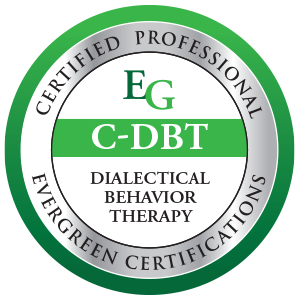DBT therapy (Dialectic behavioural therapy) and similar models. Personality Disorder Treatment Models
DBT is another particular cut down set of mindfulness principles taken from eastern psychology. Like MBCT and MBSR these are reduced tool boxes which make use of just some of the methods and principles of overall mindfulness. Like these other therapies however this does give the positive outcome of making the cut down models highly testable for research.
DBT is the original adaptation by Linehan, RO-DBT is a subsequent adaptation by Dr Thomas Lynch (Professor Emeritus University of Southampton) and has been research tested in the USA and in the UK (Lynch et al 2015:2018). DBT is appropriate for undercontrolled clients with impulse issues and chaotic presentation (see Eisenberg et al 2000, Kendler Prescott, Myers & Neale 2003), RO-DBT is designed for the other main cohort – the over-controlled, isolated and perfectionist type of client (see Caspi 2000, Chapman & Goldberg 2011, Eisenberg et al 2000). Since being created by Linehan, DBT has adapted to various settings and it might be better to refer to DBT-informed therapy, rather than DBT since there are now so many variations.
DBT was created as a direct result of CBT not being effective with groups of female clients with both Borderline Personality Disorder and suicidal tendencies. Marsha Linehan therefore developed a system to incorporate those mindfulness based themes she thought might lead to more effectiveness. The result was DBT. Linehan was a sufferer herself, and thus like Jung, used self reflection of own experience in the model development. One major outcome of this was that she realised that the therapist needed to be particularly emphatic and non judgemental. Hence, even though DBT came out of CBT, it is highly influenced by mindfulness and humanistic psychology. According to Stiglmayr et al (2014) DBT effectiveness for people with BPD was 77%. According to a study by Linehan et al (1991) in a study of drug dependent suicidal women, the drop out for therapy rate was only 36% after DBT, compared with the much higher 73% drop out of the control group. A statistically significant drug abuse level drop was also measured. DBT is used within the UK NHS as an effective treatment for a number of issues see HERE
The main differences between CBT and DBT are:
- CBT talks about “thoughts”, DBT focuses on “emotions”
- DBT has stronger in built mindfulness and psychoeducation elements
- DBT has the dialectic at it’s heart, therefore an acceptance element, wheras CBT is often said to make thoughts “wrong”.
Three “truths” are at the core of DBT:
- Everything is connected to everything else
- Change is constant and inevitable
- Opposites can be integrated, to create an approximation which is closer to the truth
Part of the reason for including these concepts, is that in long term and treatment resistant clients who have suffered for a long time, these “truths” are counter-intuitive and may be scary.
What is Dialectic in DBT?
Dialectic refers to the presence of opposites – acceptance and change within the life of the sufferer. This is part of the basic mindfulness theory in Eastern psychology and is not in any way exclusive to DBT. It requires accepting that things are interrelated – a bit like fields in Gestalt, opposites can exist peacefully, and can be discussed and reconciled.
Critically, people with long term mental health issues tend to seek the security of absolutes, and no contradiction. DBT helps to teach that it is OK and natural for opposites to exist, it is a natural part of life and does not have to be threatening.
It is important to accept that there is no definite and undeniable single truth, and it is not necessary to find one. Instead balance is needed.
What does DBT do?
DBT seeks to:
- Address life threatening behaviours
- Address therapy interfering behaviours
- Address quality of life behaviours
- Teach skills acquisition
These are very practical goals, which of course exist within almost all tailored psychotherapies for clinical mental health, including other forms of mindfulness and Cognitive Behavioural Therapies including CBASP.
There is a strong emphasis on balancing change with self acceptance, and avoiding “black and white” thinking. A strong relationship between therapist and client is vital.
Crucially DBT seeks to create client self awareness and acceptance, and to be able to differentiate between that which needs to be accepted, and that which needs change, and the wisdom to know the difference.
What are the skills focused on in DBT?
DBT focuses on:
- Mindfulness (living in the present moment naturally)
- Distress Tolerance (managing distress in a healthy way) (distracting, self soothing, improving the moment)
- Interpersonal effectiveness (once mindful and more distress tolerant, working on handling interpersonal dynamics and models. CBASP style situational analysis can be used)
- Emotion regulation
- Self acceptance and radical acceptance (not trying to fight reality)
- Balanced thinking – not absolute or black and white
- Not failing to accept the past and perceived failures, repeating self blame or suppressing with escapism, and other maladaptive mechanisms: they prolong suffering
Again, an effective and pragmatic choice of goals, also shared by many other combinations of treatment, such as mindfulness and CBASP combined. The problems that the client experienced are normal, even when they need change. Rather like in Jungian theory – issues happen because of the natural human condition. It is important to self forgive, practice acceptance, and through acceptance change can happen partly naturally (like in Gestalt), and partly planned (as in CBT).
ACCEPTS Psycho-education model
Activities and distracting with enjoyable healthy things
Contributing and helping others – compassion theory
Comparing to others in less good fortune, not to self berate, but to see positives
Emotion – identify current negative and do something to trigger a positive like laughter instead
Pushing away- choosing a new thought pattern or image
Thoughts – choosing neutral or curious thoughts, perhaps mindful colouring
Sensations – ice cube, warm bath, sensory inputs of pleasure
Visual stimulation like green space, audio like nice music, taste of food, touch of furry animal or massage, all the sensory inputs are helpful for eliciting positive feelings.
IMPROVE Psycho-Education model
Imagery – nice relaxing scene or green space
Meaning – create a positive meaning – “silver lining” to reframe
Prayer – Meditate, pray or otherwise acknowledge a higher power and reach out for strength
Relaxation – humour, meditation, music etc to elicit relaxed positive state
One thing in the moment – no multi tasking! Be mindfully present
Vacation: short breaks in the day, week etc from work / emails / stress
Encouragement – positive self talk
Pro’s and Cons of facing a situation SWOT type analysis
Before facing a stressful situation – figure out the positives -v- the negatives and pick winnable battles, but moving forward so that over time more and more distress tolerance develops. then using the above models to support when facing distress at a manageable and winnable level.
Interpersonal work for helping relationships
Most people with long term issues develop issues around positive relationships. As in with CBASP there is a strong emphasis on interpersonal therapy. one major issue is being clear what you want out of relationships- or objective effectiveness:
DEAR MAN psycho-education model
Describe in a clear and concrete way what is wanted
Express own emotions and feelings clearly to others
Assertive to express what is possible or not
Reinforce and reward the other person with smile and acknowledgement when they respond
Mindful during interaction, do not get side tracked into conflict
Appear confident, manage body language, avoid aggressive or passive
Negotiate if reasonable, be open to negotiation. No-one can get exactly what they want
For relationship effectiveness is about making interactions effective and non conflict
GIVE psycho-education model
Gentle interaction, keep arousal down, suspend judgement
Interested, pay attention to the other person, listen
Validating other person’s feelings
Easy attitude, be positive and light hearted
Self respect effectiveness means that you should maintain own values and self respect, remaining as authentic as possible during interactions.
FAST psycho-education model
Fair to others, but also self
Apologies are fine but only when needed, no global apologies
Sticking up for your beliefs and values respectfully and appropriately
Truthful, avoid lies, deceit, acting passive, or manipulation, even if scared
Stages of treatment
- Getting control over own behavioural responses, including self harm, avoiding treatment, escapism, self destructive interactions. Behaviours will have been pain avoidant, but mal-adaptation make pain worse. Small changes and positive feedback enable more change. Therapy analyses existing attempts to solve problems and helps adaptation to more healthy and effective strategies without condemning the previous motivation.
- Focusing on emotional experiences: exploring and reducing feelings of self doubt, awareness of self talk and narrative. Exploring denial and maladaption. Focus on PTSD type symptoms and patterns. Goal to strengthen and strengthen without traumatising.
- Focus on self confidence and life problem solving. More joyful activity, enable self control in relaxed way, set achievable goals, apply new skills, look forwards, dare to plan. Exploring what relationships and normal happiness look like. Build gradual self reliance and self validation.
- Achieving transcendence and building capacity for joy. Similar to Maslow theory- towards self potential and self fulfilment. Clients can recover but feel hollow, so integrating, accepting reality and better acceptance of self, resolving sense of incompleteness. Integrate past present and future.
Part of DBT is also behavioural analysis, part of the range of psychological analysis range (or psychoanalysis) and examines the chains of behavioural, hence it is also known as chain analysis.
A useful additional resource off site can be found HERE
RO-DBT for Over Controlled Personalities
RO-DBT instead focuses on over controlled, isolated, lonely or perfectionist clients, often high performing and emotionally shielded. These people hold themselves to very high standards, are very self critical and usually very serious. They can also be critical of others and may sometimes be criticised as arrogant or overcritical.
Research shows at around about 6 years old a distinct personality type: under controlled, or over controlled emerges. The under controlled child goes on to be impulsive and have issues around deferred reward and planning. The over controlled child is reserved and a good planner, but sometimes introverted.
When working with adults who are overcontrolled or perfectionist, a different set of protocols are used than in traditional DBT, and these are designed to address the excess control, excess effort, lack of “softness” and difficulty to approach.
What is available at clinic in Edinburgh
Many therapy systems come to the realisation that the same basic components and themes are needed for the treatment of conditions like depression and destructive behaviour. Therefore although not initially trained in DBT, Stuart is trained in the overall psychology which it is derived from, and has trained in the applied skills through MBCT, CBASP, CBT, ACT, RO-DBT and Teaching mindfulness training. He has then completed DBT skills training for professionals enabling him to use DBT and RO DBT methods, as well as using the latest adaptations to the DBT system. He has completed CPD training in DBT, RO DBT, Mindfulness and ACT. He has completed integrative training for professionals from leading experts and study of RO-DBT. Stuart is a C-DBT certified DBT specialist. he has also completed additional more holistic courses including:
- Certificate in DBT for practitioners.
- Certificate. Real World DBT: Adapting DBT to Fit Your Practice, (CPD) (Cert).
- Certificate. DBT: The Latest in Practice-Based innovation. (Trauma, Bipolar, Co-morbidity)
- Certificate: Clinical Mindfulness for Practitioners
- Certificate: ACT for Practitioners
Key Words
DBT, dialectic behavioural therapy, mindfulness, CBT, psychotherapy, eastern psychology, psychoanalysis, CBASP, interpersonal psychotherapy, counselling, teaching mindfulness, mindfulness for depression, mindfulness with borderline personality disorders, Edinburgh, Midlothian, Stirlingshire, Scotland, Stress, Anger, relationships, suicide risk, self harm, trauma, PTSD, self injury,addictive behaviours, suicidal thoughts, intense emotions, self destructive behaviours, personality disorders, suicidal ideation, eating disorders .
Contact via the contact us page HERE
Common Search terms
anxiety, addictions, quit smoking, phobias, fear of flying, weight loss, panic attacks, gastric band hypnotherapy, alcohol abuse, food addiction, gambling addiction, depression, drug abuse, sleep disorders, insomnia, eating disorders, sexual issues, pain management, irritable bowel syndrome, low self-confidence, post-traumatic stress disorder (ptsd), sex addiction, relationship issues, sports performance, obsessions and compulsions, low self-esteem, stress, exam stress, blushing, tinnitus, childbirth, anger management, relaxation, chronic fatigue syndrome, bruxism (teeth grinding), public speaking, stuttering, anxiety, generalised anxiety disorder, relationship issues, depression, panic disorder, phobias, feeling sad, family issues, affairs and betrayals, separation and divorce, seasonal affective disorder (sad), bipolar disorder, postnatal depression, addiction(s), abuse, bereavement, low self-esteem, child related issues, personality disorders, alcoholism, low self-confidence, stress, anger management, sexual abuse, emotional abuse, depression and anxiety in children, sex addiction, eating disorders, drug abuse, borderline personality disorder, gambling, post-traumatic stress disorder (ptsd), binge-eating disorder, sex problems, behaviour problems, trauma, obsessive compulsive disorder (ocd), hoarding, suicidal thoughts, smoking, internet addiction, work-related stress, separation anxiety, loneliness, childhood bullying, attachment disorder in children, domestic violence, childhood bereavement, anorexia nervosa, children’s learning difficulties, narcissistic personality disorder, bulimia nervosa, asperger’s syndrome, self-harm, gender dysphoria, physical abuse, obsessive-compulsive personality disorder, avoidant personality disorder, sexuality, career, autism, adhd, dependent personality disorder, dissociation, paranoid personality disorder, antisocial personality disorder, schizoid personality disorder, histrionic personality disorder, schizotypal personality disorder, attachment disorder, body dysmorphic disorder, passive aggressive behaviour, infertility, chronic fatigue syndrome/me, paranoia, miscarriage, carer support, young carers, abortion, cancer counselling, disabilities, spirituality, bullying, adoption, pregnancy and birth,mlearning difficulties, hearing voices, dementia, redundancy, psychosis, discrimination, mental health, schizophrenia, tourette’s syndrome, hiv/aids counselling, supervisor, supervision, cbt, supervisors, Edinburgh, Midlothian, Glasgow, Falkirk, Scotland







